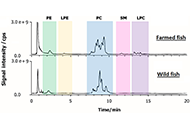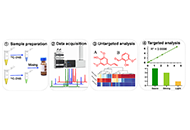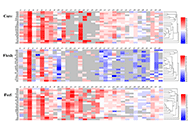Aim:
This study aims to develop sensitive and reliable analytical technologies to enable the distinction between wild-caught and farmed fish through appropriate molecular markers to protect consumers from fraudulent fish labelling. Gilthead sea bream, Sparus aurata L. (S. aurata L.), is a very common fish used as foodstuff worldwide and globally produced in aquaculture in the Mediterranean basin. Wild-caught and farmed species are very different in feed and lifestyle and the quality and safety of these products strongly depend on fish growth, processing history, and storage conditions.
Results:
The untargeted approach led to the annotation of a total of 216 phospholipids (PLs), namely 65 phosphatidylethanolamines (PEs), 27 lyso-PEs (LPEs), 61 phosphatidylcholines (PCs), 34 lyso-PCs (LPCs), and 29 sphingomyelins (SMs). Untargeted lipidomics data were investigated by principal component analysis (PCA) and K-means clustering. Lyso-PLs (LPLs) of PEs and PCs including ether-linked side chains were found as discriminating markers between the two types of fish samples. The PLs that were most responsible for distinguishing between the lipid extracts of farmed and wild S. aurata fillets were successfully characterized by tandem mass spectrometry (MS/MS). The analysis revealed that wild fillet lipid extracts contained some PE exhibiting ether bonds (PE P-), viz. 16:0, 18:0, 18:1, and 18:2 and polyunsaturated fatty acyl chains (i.e., 22:6 and 22:5). In farmed species, the estimated abundance ratios of fatty acyl chains 20:4/18:2 and 22:6/20:5 were 0.9 and 0.05, respectively. However, in wild-caught fish, these ratios were found to be two-fold higher and four-fold higher, respectively.
 Untargeted lipidomics for evaluating fish authenticity: the case of wild-caught and farmed species of Sparus aurataOpen AccessOriginal ArticleAim: This study aims to develop sensitive and reliable analytical technologies to enable the distinction between wild-caught and farmed fish through appropriate molecular markers to protect consu [...] Read more.Sara Granafei ... Tommaso R.I. CataldiPublished: June 30, 2023 Explor Foods Foodomics. 2023;1:83–100
Untargeted lipidomics for evaluating fish authenticity: the case of wild-caught and farmed species of Sparus aurataOpen AccessOriginal ArticleAim: This study aims to develop sensitive and reliable analytical technologies to enable the distinction between wild-caught and farmed fish through appropriate molecular markers to protect consu [...] Read more.Sara Granafei ... Tommaso R.I. CataldiPublished: June 30, 2023 Explor Foods Foodomics. 2023;1:83–100 Untargeted and quantitative analyses of amine and phenol compounds in Baijiu via chemical isotope labelingOpen AccessOriginal ArticleAim: The aim of this study is to comprehensively investigate the distribution of amine and phenol compounds in different flavors of Baijiu. Methods: 12C-/13C-dansyl chloride labeling was [...] Read more.Xiaoyu Xie ... Guowang XuPublished: June 30, 2023 Explor Foods Foodomics. 2023;1:72–82
Untargeted and quantitative analyses of amine and phenol compounds in Baijiu via chemical isotope labelingOpen AccessOriginal ArticleAim: The aim of this study is to comprehensively investigate the distribution of amine and phenol compounds in different flavors of Baijiu. Methods: 12C-/13C-dansyl chloride labeling was [...] Read more.Xiaoyu Xie ... Guowang XuPublished: June 30, 2023 Explor Foods Foodomics. 2023;1:72–82 Correlation distance of browning characteristic and polyphenol distribution in apple slices from 20 Chinese cultivarsOpen AccessOriginal ArticleAim: The aim of this study is to investigate the polyphenol composition and distribution in the core, flesh, and peel of 20 apple varieties from China and its relation with browning characteristi [...] Read more.Wenyue Wang ... Jinfeng BiPublished: June 08, 2023 Explor Foods Foodomics. 2023;1:62–71
Correlation distance of browning characteristic and polyphenol distribution in apple slices from 20 Chinese cultivarsOpen AccessOriginal ArticleAim: The aim of this study is to investigate the polyphenol composition and distribution in the core, flesh, and peel of 20 apple varieties from China and its relation with browning characteristi [...] Read more.Wenyue Wang ... Jinfeng BiPublished: June 08, 2023 Explor Foods Foodomics. 2023;1:62–71